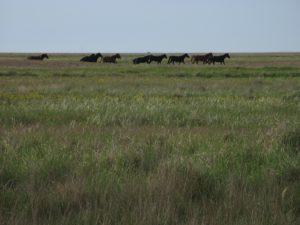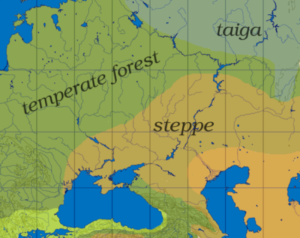
Genomic analyses of nomads from Europe and Asia has revealed that the ancestors of most western Iron Age nomads were individuals from the eastern Pontic-Caspian steppe, a region that experienced great population movements during this time. These findings* shed light on the nomadic tribes that had significant impact on the cultural development of Eurasia. The Pontic-Caspian steppe, which connects eastern Europe to western Kazakhstan, was inhabited by nomadic populations during the Bronze and Iron Ages (1800 BCE to 400 CE). While their presence during this time is confirmed from archaeological research, the genomic structure of the Bronze Age peoples (the Srubnaya-Alakulskaya cultures) and of the Iron Age populations (including the Cimmerians, Scythians, and Sarmatians) in the region has not been fully explored. Maja Krzewińska and colleagues analyzed genomic data for 35 Bronze Age and Iron Age individuals from the Pontic-Caspian steppe from four chronologically sequential cultural groups: 13 Srubnaya-Alakulskaya individuals, 3 Cimmerians, 14 Scythians and 5 Sarmatians – all radiocarbon-dated to have lived between 1900 BCE and 400 CE. The researchers’ analyses of these individuals’ genomic data revealed many genetic links between the Cimmerians and Sarmatians, suggesting that they shared a common ancestral gene pool. However, no group can be deemed a direct ancestor of another group, Krzewińska et al. say. Despite no direct link, these individuals possess common genetic signatures maintained over the years from peoples from eastern fringes of the Pontic-Caspian steppe. This, say the authors, suggests western Eurasian steppe nomads that survived into the Iron Age were not direct descendants of the Bronze Age Srubnaya-Alakulskaya peoples, but rather, that they descended from peoples of the eastern Pontic-Caspian steppe region.
________________________________

Map showing the Pontic-Caspian steppe grasslands region of the Eurasian Steppe, in Eurasia. Dbachmann, Wikimedia Commons
________________________________

A view of the Steppe. YegorGeologist, Wikimedia Commons
________________________________
Article Source: A Science Advances news release
*”Ancient genomes suggest the eastern Pontic-Caspian steppe as the source of western Iron Age nomads,” by M. Krzewińska; G.M. Kılınç; J. Storå; A. Götherström at Stockholm University in Stockholm, Sweden; A. Juras; M. Chyleński; S. Łukasik; M. Krenz-Niedbała at Adam Mickiewicz University in Poznań in Poznań, Poland; D. Koptekin at Middle East Technical University in Ankara, Turkey; A.G. Nikitin at Grand Valley State University in Allendale, MI; N. Shcherbakov; I. Shuteleva; T. Leonova at Bashkir State Pedagogical University in Ufa, Russia; L. Kraeva at Orenburg State Pedagogical University in Orenburg, Russia; F.A. Sungatov; A.N. Sultanova at Bashkir State University in Ufa, Russia; I. Potekhina at National Academy of Sciences of Ukraine in Kiev, Ukraine; L. Dalén at Swedish Museum of Natural History in Stockholm, Sweden; V. Sinika at Taras Shevchenko University in Tiraspol in Tiraspol, Moldova; V. Sinika at Nizhnevartovsk State University in Nizhnevartovsk, Russia; M. Jakobsson at Human Evolution in Uppsala, Sweden; M. Jakobsson at University of Johannesburg in Auckland Park, South Africa.





